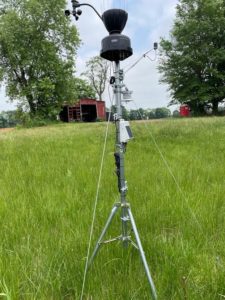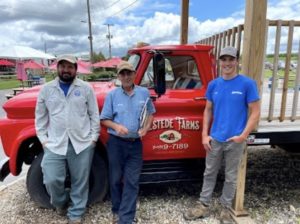Climate Smart Farming
Climate Smart Farming
We are continuing to improve our innovations in farming with the addition of four new weather stations on our farm. These four different stations are less than one year old and are a way to utilize technology for saving time & improving efficiency while aiding our water conservation efforts and enhancing farming techniques. Our weather… Read More »

Our weather station monitors various important info linked to NEWA, Network for Environment and Weather Applications. These stations monitor very important items for farmers including; wind speed & direction, relative humidity & dew point, temperature, precipitation or rainfall, leaf wetness, solar radiation, aka, the strength of the sun.
These weather stations are cloud based and allow us to track weather conditions to properly access farm management decisions. This information is made more accurate now that we are using data collected from actual on farm locations rather than utilizing weather stations in nearby locations as we have done in the past which could be miles away. John Ferrante, our assistant farm production manager stated “There are varying weather conditions between all of our farm properties. We’ve witnessed varied rainfall patterns up to 3” difference in one day between our farmland which could affect farm management and irrigation decisions differently.” John was instrumental in obtaining these weather stations for the production team along with Craig Steely, farm production manager and Hector Ruiz, assistant farm production manager. John found out about these weather stations from attending farming conferences over the Winter and also from his studies while in college. The production team loves that we are connected to other farms with our stations. This connectivity promotes sharing of information and knowledge and a data pool to collect statistics to help predict trends, farmers helping farmers.
Weather conditions change with the shift in wind direction, and staying on top of the weather is important for farmers. Here’s a breakdown of some of the features of the weather stations. Temperature & left wetness assists with calculations and management of irrigation. Pests, fungi, and disease may be more impactful to crops when the humidity is high so knowing this info helps reduce the likelihood of plant diseases and crop failure. Wind speed and direction is important to farming as wind can affect the supply of carbon dioxide resulting in greater photosynthesis speeding up growth rates. Relative humidity refers to the moisture content in the atmosphere or how much water the air can hold at a given temperature without condensation. The amount of moisture in the air affects the transpiration rate in plants. In other words, how water and nutrients move to different parts of the plant all impact leaf growth, photosynthesis and pollination. You can see how important this information is to successful crops and to ensure we are able to maximize food production to feed people!
Some of our future goals are to have the weather stations tied to instruments & soil sensors that will allow automated irrigation maximizing water conservation efforts. Stay tuned for updates on our weather stations!







